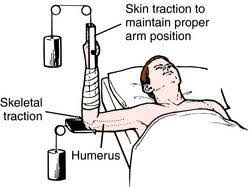A nurse is discussing the differences between skeletal and skin traction with a newly licensed nurse. Which of the following statements by the newly licensed nurse indicates understanding?
Clients with skin traction have more mobility than those with skeletal traction.
Clients with skin traction have more discomfort than those with skeletal traction.
Skeletal traction is more appropriate than skin traction for reducing a fracture.
Skeletal traction has less risk for infection than skin traction.
The Correct Answer is C
Choice A reason:
Skin traction is indeed less restrictive than skeletal traction, allowing for more mobility. It is applied using bandages or adhesive material to the skin, which can be removed or adjusted more easily than the pins or screws used in skeletal traction. This type of traction is typically used for short-term treatment before surgery or when the injury is less severe.
Choice B reason:
Discomfort levels can vary depending on the individual and the specific circumstances of the traction. However, skin traction is generally considered to be less painful than skeletal traction because it is less invasive and applies less force. Skeletal traction, which involves the insertion of pins or wires directly into the bone, is likely to cause more discomfort due to the invasive nature of the procedure.
Choice C reason:
Skeletal traction is more appropriate for reducing fractures, especially in cases where a greater force is needed to align the bones. It involves the surgical insertion of pins or wires directly into the bone, allowing for a stronger and more stable pull that is necessary for the realignment of complex fractures.
Choice D reason:
Skeletal traction carries a higher risk of infection compared to skin traction because it is more invasive. The insertion of pins or wires into the bone creates a potential entry point for bacteria, which can lead to infection at the site of insertion.

Nursing Test Bank
Naxlex Comprehensive Predictor Exams
Related Questions
Correct Answer is D
Explanation
Choice A reason:
Monitoring temperature is important postoperatively as it can indicate infection or inflammation. However, it is not the immediate priority following a thyroidectomy. The primary concern post-thyroidectomy is ensuring the airway is not compromised due to swelling or bleeding.
Choice B reason:
Monitoring urination is part of postoperative care to ensure kidney function and that the body is adequately eliminating fluids. While important, it is not the priority in the immediate postoperative period following a thyroidectomy.
Choice C reason:
Pain control is essential for patient comfort and recovery. However, while managing pain is a significant aspect of postoperative care, it is not the most critical priority following a thyroidectomy. The nurse must first ensure that the airway is clear.
Choice D reason:
Airway patency is the priority for monitoring a client post-thyroidectomy. Due to the proximity of the surgery to the trachea, there is a risk of swelling, hematoma, or other complications that could lead to airway obstruction. Ensuring the client has a patent airway is crucial to prevent respiratory distress or compromise.
Correct Answer is B
Explanation
Choice A reason:
Squamous cell carcinoma typically presents as a rough, scaly, red patch, open sore, or raised growth with a central depression, often on sun-exposed areas of the body. While it can appear as a lesion that varies in color, it is not commonly associated with a nevus that has increased in size.
Choice B reason:
Malignant melanoma is associated with changes in preexisting nevi, such as an increase in size and variations in color. It often appears as a mole that changes in color, size, or feel and may have irregular edges. The description of the lesion provided by the client is characteristic of malignant melanoma, making this the correct diagnosis.
Choice C reason:
Kaposi's sarcoma is a cancer that forms in the lining of blood and lymph vessels and typically appears as patches of abnormal tissue on the skin or mucous membranes. These lesions are usually red or purple and look similar to bruises¹. They are not typically described as nevi that increase in size or lesions that vary in color.
Choice D reason:
Basal cell carcinoma often appears as a slightly transparent bump on the skin, though it can take other forms. It usually presents as a pearly white or pink bump on white skin, or a brown or black bump on darker skin, and is most often found on sun-exposed areas. It is not typically associated with a nevus that has increased in size or an irregularly shaped lesion that varies in color.
Whether you are a student looking to ace your exams or a practicing nurse seeking to enhance your expertise , our nursing education contents will empower you with the confidence and competence to make a difference in the lives of patients and become a respected leader in the healthcare field.
Visit Naxlex, invest in your future and unlock endless possibilities with our unparalleled nursing education contents today
Report Wrong Answer on the Current Question
Do you disagree with the answer? If yes, what is your expected answer? Explain.
Kindly be descriptive with the issue you are facing.
